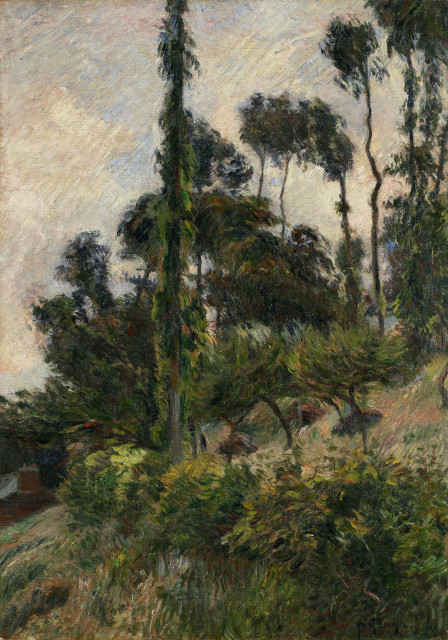- FR
S’inscrire
- Acheter
- Vendre
- Plus
- Galerie
- Commerce d'art
- Maison d'Édition
- Kornfeld aujourd’hui
- L'histoire de la Maison
- Informations



Paris 1848 - 1903 Hiva-Hoa (Marquesas)
1884
Oil on canvas
65x46 cm
Lower right signed and dated by the artist "P. Gauguin 84"
Georges Wildenstein, Gauguin, Catalogue, Paris 1964, no. 115
Daniel Wildenstein, Gauguin, Catalogue de l'œuvre peint, Paris 2001, no. 126
Auktion Hôtel Drouot, Paris, Me Baudoin, 12.4.1943, cat. no. 111
Auktion Sotheby’s, London, 30.6.1987, cat. no. 17
Auktion Christie’s, New York, 11.5.1988, cat. no. 12
Swiss private collection
Auktion Christie's, Paris, 1.12.2011, cat. no. 22
International privtae collection
Yokohama/Hiroshima/Kyoto 1992, Museum of Arts, Gauguin et ses amis peintres,
The canvas relined, lightly varnished. In very good overall condition
After the "stock market crash" of 1882, Gauguin lost his job and decided to devote himself exclusively to painting against the great resistance of his family. He had been active as an artist since the mid-1870s and from 1879 was invited to take part in group exhibitions by the Impressionists. The works were under the great influence of his mentor and teacher Camille Pissarro, in 1881 the encounter and collaboration with Paul Cezanne in Pontoise were also formative. The paintings from this period still show the characteristic features of Impressionism, such as the use of pure colors, the divisionist painting principle and the central representation of light
As the cost of living in Paris became too high for his wife and five children, the family moved to the port city of Rouen in Normandy, in 1884. However, the family soon traveled on to Copenhagen, where his wife Mette-Sophie was originally from. Gauguin stayed in Rouen, where he created his own unique Impressionist style, which will clearly shape his later work in Pont-Aven and Tahiti, such as the treatment of the flora. The dense compositions are already in place, the painting offered here impressively outlines his unique, artistic path in the elaboration of the sky and the foliage. In Rouen, he was particularly fascinated by the light, the motifs are rural life and the magnificent landscapes. "À flanc de coteau", "on the slope", is an impressive composition, the diagonal picture arrangement accentuates the dynamics of the picture. The free, unbound nature that will shape the paintings from Tahiti can already be felt
The painting offered here is certainly one of the highlights of the artist's early work. At the end of 1884 he will follow his family to Copenhagen for a short time before finally going his own radical path as the main exponent of synthetism. These early paintings of such high quality are rarely in private hands today
1884
Öl auf Leinwand
65x46 cm
Unten rechts vom Künstler signiert und datiert "P. Gauguin 84"
Georges Wildenstein, Gauguin, Catalogue, Paris 1964,
Daniel Wildenstein, Gauguin, Catalogue de l'œuvre peint, Paris 2001,
Auktion Hôtel Drouot, Paris, Me Baudoin, 12.4.1943,
Auktion Sotheby’s, London, 30.6.1987,
Auktion Christie’s, New York, 11.5.1988,
Schweizer Privatsammlung
Auktion Christie's, Paris, 1.12.2011,
Internationale Privatsammlung
Yokohama/Hiroshima/Kyoto 1992, Museum of Arts, Gauguin et ses amis peintres,
Die Leinwand doubliert, leicht gefirnisst. In sehr guter Gesamterhaltung
Nach dem "Börsencrash" von 1882 verlor Gauguin seine Arbeitsstelle und beschloss, sich gegen den grossen Widerstand seiner Familie fortan ausschliesslich der Malerei zu widmen. Seit Mitte der 1870er Jahre war er schon als Künstler aktiv und wurde ab 1879 eingeladen, an den Gruppenausstellungen der Impressionisten teilzunehmen. Die Werke standen unter grossem Einfluss seines Mentors und Lehrers Camille Pissarro, prägend waren 1881 auch die Begegnung und die Zusammenarbeit mit Paul Cezanne in Pontoise. Die Gemälde aus dieser Zeit weisen noch die charakteristischen Merkmale des Impressionismus auf, also etwa die Verwendung der reinen Farben, das divisionistische Malprinzip und die zentrale Darstellung des Lichts
Da die Lebenskosten in Paris für seine Frau und die fünf Kinder zu hoch wurden, zog die Familie 1884 in die Hafenstadt Rouen in die Normandie. Die Familie reiste jedoch schon bald weiter nach Kopenhagen, woher seine Frau Mette-Sophie ursprünglich stammte. Gauguin blieb in Rouen und schuf dort einen einzigartigen, eigenen impressionistischen Stil, der seine späteren Arbeiten in Pont-Aven und Tahiti, etwa die Behandlung der Pflanzenwelt, klar prägen wird. Schon jetzt sind die dichten Kompositionen angelegt, das hier angebotene Gemälde zeichnet in der Ausarbeitung des Himmels und des Blattwerks eindrücklich seinen einzigartigen, künstlerischen Weg vor. In Rouen faszinierte ihn vor allem das Licht, die Motive sind das ländliche Leben sowie die grossartigen Landschaften. "À flanc de coteau", "am Hang", ist eine beeindruckende Komposition, die diagonale Bildanlage akzentuiert die Dynamik des Bildes. Bereits ist die freie, ungebundene Natur, die für die Gemälde aus Tahiti prägend werden wird, spürbar
Das hier angebotene Gemälde gehört sicherlich zu den Höhepunkten der frühen Arbeiten des Künstlers. Noch Ende 1884 wird er seiner Familie für kurze Zeit nach Kopenhagen folgen, bevor er endgültig seinen eigenen, radikalen Weg als Hauptvertreter des Synthetismus gehen wird. So qualitätvolle, frühe Gemälde befinden sich heute nur noch selten in Privatbesitz




